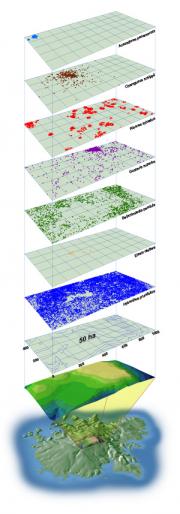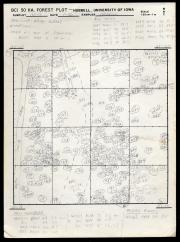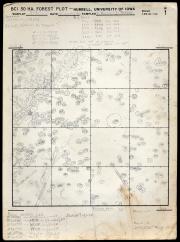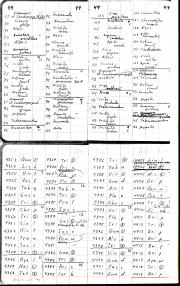 At the Smithsonian Institution Archives, five tall document boxes arrived on a cart. These boxes harbor a tropical forest – or at least a snapshot of a forest in time.
At the Smithsonian Institution Archives, five tall document boxes arrived on a cart. These boxes harbor a tropical forest – or at least a snapshot of a forest in time.

They contain the records of the first tree census of the Barro Colorado Island (BCI) Forest Dynamics Project, carried out between 1980 and 1982. Its task: to tag, identify, measure, and map every plant possessing a stem larger than one centimeter in diameter within the bounds of a 50-hectare plot of Panamanian forest. In 1979, when biologists Stephen Hubbell and Robin Foster imagined the project as a way to study tropical tree diversity, no one had attempted a forest census at this scale. The use of quadrats - small, square plots - for sampling species goes back to the 1890s in ecology. Sampling tree diversity in Panama, however, poses problems. Unlike temperate forests dominated by one or two species, in the tropics, tree diversity reigns supreme. In other words, to understand tropical tree diversity, you’re going to need a bigger plot.
The result of a bigger plot was bigger data. Within each archival box, folder after folder contains a series of 1,250 gridded maps, each representing a 20 by 20 meter subplot of the forest. The maps contained in these boxes record 208,400 individual trees and amount to an astounding 299 species.

In the archives, far from Panama, I flipped through page after page of these grids. Each was laboriously filled out by hand, crowded with the outlines of tree trunks, rocks, fallen logs, and tangles of lianas – every individual tree labeled with a number. This paper forest seems an extravagant attempt to capture a forest’s complexity – and they represent just the first census.
Yet, this is not a matter of missing the forest for the trees. By re-censusing the plot every five years since 1980, scientists have been revealing a forest in a state of constant change. This is significant – throughout the 19th and 20th centuries, most people imagined tropical forests as primeval and unchanging. But a combination of fine-scale mapping and long-term censusing showed that the 50-hectare plot on BCI was anything but stable. As trees lived and died, the composition of species in the plot shifted – changes tied to El Niño cycles and drought. Gradually, the BCI plot became the model for a global network of plots, and ecologists are beginning to appreciate both the individuality of different forests and their shared responses to global change.
 Today, we have become used to large-scale, highly technical projects to monitor global environments – from GPS-tagged elephant herds to the satellite imaging of arctic ice. We are accustomed to the eye in the sky. For this reason, these five boxes are important to scientists, historians, and the public. The maps within them document not only the plot itself, but the hard, on-the-ground work it took to change long-held ideas about tropical forests. The maps were pencilled in by hand by a small team of scientists and technicians. Although gridded and sharing a standardized set of data, the personality of the researchers comes through in handwriting, drawing styles, and eclectic mixtures of Spanish and English in notations. The tropical forest leaves a literal mark in water stains and dirt. And the work of science did not end in the field; notes and corrections show how each map passed through multiple hands, undergoing repeated checks to identify and correct errors, and improve methods for the next census. The messy, iterative process of science, visible in these field maps, is obscured by entry into databases and the reproduction of neat, electronically-rendered maps (although surely painstaking work, especially using 1980s computers). Going back to the original maps brings the scientific process back to life.
Today, we have become used to large-scale, highly technical projects to monitor global environments – from GPS-tagged elephant herds to the satellite imaging of arctic ice. We are accustomed to the eye in the sky. For this reason, these five boxes are important to scientists, historians, and the public. The maps within them document not only the plot itself, but the hard, on-the-ground work it took to change long-held ideas about tropical forests. The maps were pencilled in by hand by a small team of scientists and technicians. Although gridded and sharing a standardized set of data, the personality of the researchers comes through in handwriting, drawing styles, and eclectic mixtures of Spanish and English in notations. The tropical forest leaves a literal mark in water stains and dirt. And the work of science did not end in the field; notes and corrections show how each map passed through multiple hands, undergoing repeated checks to identify and correct errors, and improve methods for the next census. The messy, iterative process of science, visible in these field maps, is obscured by entry into databases and the reproduction of neat, electronically-rendered maps (although surely painstaking work, especially using 1980s computers). Going back to the original maps brings the scientific process back to life.
The practices that shape our understanding of our environment have roots in particular times and places. At BCI, they have a much deeper history than one might expect – one illuminated by records at the Smithsonian Institution Archives. It is no coincidence that the first 50-hectare Forest Dynamics Plot started on BCI. Although the plot was not founded until 1980, ecological research on the island itself stretches back to the 1920s. Decades of baseline data and protection from development made such an ambitious long-term project possible. In my ongoing book project, I examine the roots of tropical biology and ideas about biodiversity, particularly as shaped by long-term, place-based research such as this.
Related Resources
- The History of the Smithsonian Tropical Research Institute, Smithsonian Institution Archives
- Smithsonian Institution Global Earth Observatories
Related Collections
- Accession 13-025 - Smithsonian Tropical Research Institute, Research Records, 1981-1983, Smithsonian Institution Archives
Produced by the Smithsonian Institution Archives. For copyright questions, please see the Terms of Use.

Leave a Comment